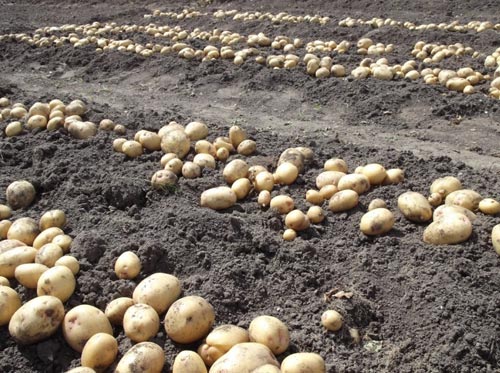 Potatoes are one of the most popular crops in our latitudes. This product is indispensable on our table. Let's look at the detailed characteristics of the vegetable and its best varieties in order to grow truly high-quality and tasty potatoes.
Potatoes are one of the most popular crops in our latitudes. This product is indispensable on our table. Let's look at the detailed characteristics of the vegetable and its best varieties in order to grow truly high-quality and tasty potatoes.
Content
Description and characteristics of potatoes
Potato belongs to nightshade crops, its homeland is Argentina and Pe Initially, the vegetable was small and unproductive, but after moving to its second homeland, in Chile, it changed. The fruits have become larger in size, but have lost their taste because they have reduced the amount of protein. Because of this, potatoes have also become less resistant to disease. Currently, many varieties of vegetables are bred, each of which has its own qualities.
Composition description (all data are based on 100 g of product):
- calorie content - 77 kcal;
- proteins - 2 g;
- fats - 0.4 g;
- carbohydrates - 16.3 g;
- organic acids - 0.2 g;
- dietary fiber - 1.4 g;
- water - 78.6 g;
- ash - 1.1 g;
Potatoes also include:
- vitamins (A, groups B, E, H, etc.);
- macroelements (potassium, calcium, magnesium, sodium, sulfur, phosphorus, chlorine);
- trace elements (aluminum, boron, vanadium, iron, iodine, copper, etc.);
- digestible carbohydrates, essential and non-essential amino acids, various fatty acids.
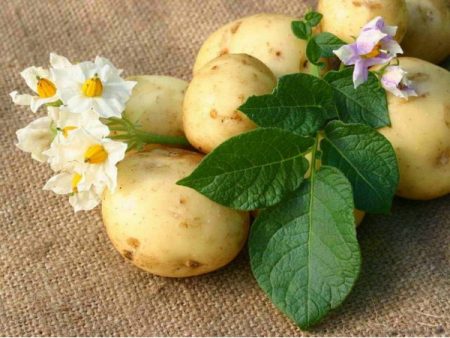
Advantages and disadvantages
The advantages of potatoes:
- the abundance of nutrients in the composition;
- it is an inexpensive, nutritious and nutritious food;
- undemanding to leaving, often grows even in poor conditions;
- good taste;
- range of use from cooking to traditional medicine;
Cons of potatoes:
- immature and sprouted fruits are toxic;
- an abundance of carbohydrates and a lack of proteins in the composition;
- contraindications for diabetics and obese people.
Potato growth stages
From the time of planting to complete death, the vegetable goes through 4 stages of development.
- The emergence of seedlings. The maternal tuber becomes a source of nutrients for the new bush. Growth begins with the upper ocelli.
- Budding. During this period, the root system is developed enough not to need a mother tuber. Tubers begin to form, stems and leaves are actively developing, buds appear.
- Bloom. Flowers appear, tubers develop rapidly and gain mass.
- Dying tops. The tops of vegetables begin to slowly and imperceptibly die even before the final formation of the fruits. It should be removed from the garden about 10-12 days before harvest to accelerate the maturation of tubers.
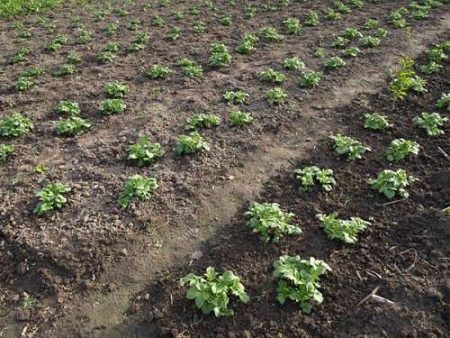
Potato soil
Many factors influence potato planting - temperature, light, humidity, pest, etc., but the main one is soil. Most potato is suitable for loose and light soil. These include loamy, sandy, peat and chernozem soils. It is important to consider that the vegetable easily tolerates acidic soil, but it is better to give preference to slightly acidic, and in other cases, apply liming.
The most inappropriate type of land is heavy clay. It is very dense and does not allow air to pass through, which harms landings. Also, potatoes do not like sandy and podzolic soil.
In general, potatoes can grow on any land, but unsuitable species require careful preparation and care.You should know exactly what soil is located on the selected site in order to properly prepare it for planting.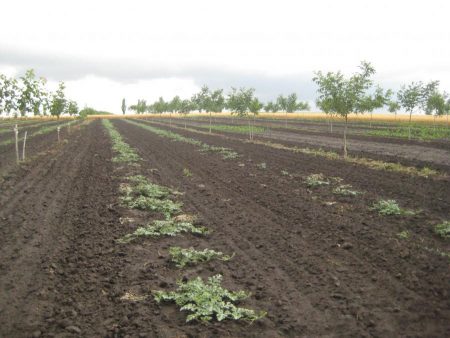
Storage Features
Varieties currently popular are designed for long-term storage. To keep your potatoes quality until the next spring, you must observe some important conditions.
- Before picking the fruit in the storage place, carefully sort them. Sick and badly damaged tubers must not be stored with healthy tubers: they can ruin the entire crop. All potatoes for storage must be whole, dry, sproutless, clean and ripe.
- Immediately after digging, it is better to leave the crop in the garden for a couple of hours so that it dries.
- The potato vault should be dark. Humidity - 85-90%, temperature - approximately + 3 ° С.
- In spring, you need to lower the temperature at the storage location by about 1.5-2 ° C so that the potatoes do not begin to germinate.
- The best options for storing the root crop are to keep it in containers or drawers. Storage in bulk can lead to rapid death of the crop.
The best varieties for long-term storage, including winter storage: Gatchinsky, Zhuravinka, Atlant, Asterix, Saturn, Dauphiné, Impala, Nevsky, RedScarlet.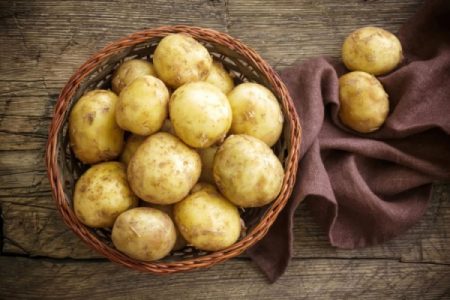
The best varieties
To grow good potatoes, you need to know the main information about the most common varieties: yield, tuber size, stability, keeping quality, the possibility of long-term storage. Let's look at the varieties recognized as the best, and their main characteristics.
Dauphine
The homeland of the variety is Holland. It has a great taste. The average yield is 250 centners per hectare. On average, root crops weigh about 300 grams, and on one bush there can be up to 20 pieces. Root crops are round, with a light skin. The variety is unpretentious, requires only plentiful watering, and is also resistant to various diseases and pests. It has excellent keeping quality, retains taste and presentable appearance for about 9 months of storage.
Share
The bushes of this potato reach 80 cm in height, the stems and branches are strong. Tubers weighing about 400 grams each, one plant produces about 15 fruits. Each potato is round, delicate beige. All root crops are approximately the same in shape and size, which is good when sold. Productivity - about 400 kg / ha. Plantings are rarely affected by diseases and pests, require regular watering and fertilizer. The variety tastes good.
Gourmet
This is one of the colored types of potatoes, which has a dark purple peel and white-purple pulp. Externally, tubers are more like beets than potatoes. The variety was bred not so long ago, but has already won the favor of gardeners. Each fruit weighs about 100 g, 12-14 fruits usually grow on one bush, they have an elongated oval shape. Eyes are few and they are superficial. Bushes up to 70 cm high, leaves are small, light green. Excellent indicators of stability, keeping quality and immunity.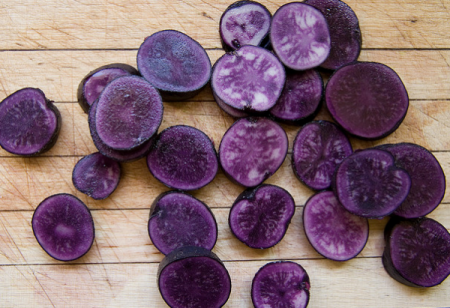
Early grades
Many gardeners prefer early ripe potatoes. Such varieties allow you to quickly harvest, and in the southern regions - to get it twice a season.
RedScarlet (Holland)
This variety requires plenty of sunlight, so it is more suitable for southern areas. Ripening is uniform, potatoes are resistant to drought and disease, stored for a long time. Productivity - about 500 kg / ha, tuber weight - 80-120 gr. The pulp of the tubers is yellowish, they themselves are rounded, even. This is a table variety, actively used for cooking any dishes.
Luck (Russia)
An elite variety that perfectly suits the difficult climatic conditions of Russian latitudes. It is unpretentious to the soil, but requires careful maintenance, watering and an abundance of fertilizers. The mass of one tuber is about 180 grams, but giants are also found (up to 600 grams). One bush gives an average of 20-25 tubers. With good care, yields can be extremely high, up to 960 kg / ha. The tubers are attractive in appearance, rounded and even. Good taste, high keeping quality.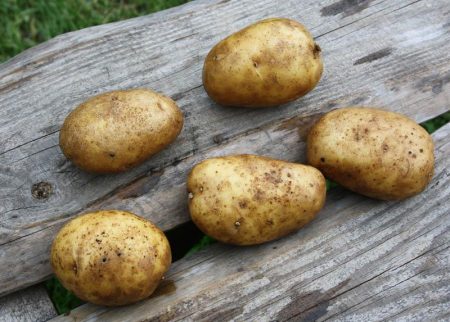
Rosara (Germany)
Planting requires abundant watering and fertilizer, otherwise undemanding. Bushes are large, up to 70 cm in height, powerful and strong. The potatoes are small (up to 150 g), under the bush there can be 20-30 pieces, of a neat shape, smooth. Productivity - up to 400 kg / ha. The peel may be reddish or brown. The fruits are well boiled and have a pleasant aroma. The variety is unstable to the attack of the Colorado potato beetle.
Bellarosa (Germany)
Sometimes this variety is also called Bela Rosa. The fruits are brown, smooth and neat, the average weight of each is 200 g. The peel is pink, slightly rough. The average yield is 350-400 centners per hectare. The variety grows poorly on depleted land, so it is usually planted on a site where legumes were previously grown. Resistant to mild cooling and drought. The fruits are rich in starch and taste good. Bellarose requires watering 3 times per season.
Impala (Netherlands)
Oval milky beige root vegetables with a thick, smooth peel. The weight of each potato can reach 160 g, in one hole there are about 15 fruits. The total yield is approximately 40 t / ha. Potatoes are resistant to bad weather, mechanical damage and disease. It perfectly retains all its qualities during long-term storage. It has a pleasant taste, does not fall apart and does not darken during cooking.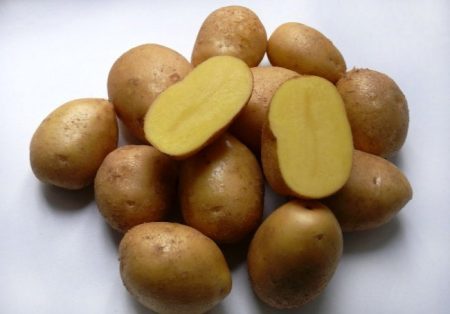
Medium grades
This type of variety is one of the most popular. Most of its varieties are undemanding to care.
Gala (Germany)
Shrubs are low and unattractive in appearance (up to 50 cm in height), often yellowish, sluggish. They require a lot of fertilizers, otherwise undemanding, resistant to disease. Root crops weigh up to 400 grams each, under the bush they are usually 5-6 pieces. Productivity - about 350 centners per hectare. The flesh is yellowish, the peel is rough, brownish.
Nevsky (Russia)
The tubers are elongated, beige, with a pinkish tinge. The potato has a thin peel and pleasant taste. Excellent keeping quality, stored until spring. The average weight of the root crop is 120 g, under the bush there are 10-15 pieces, the yield is 300 c / ha. The variety requires frequent watering and top dressing with organic fertilizers. It has good immunity to various diseases and pests.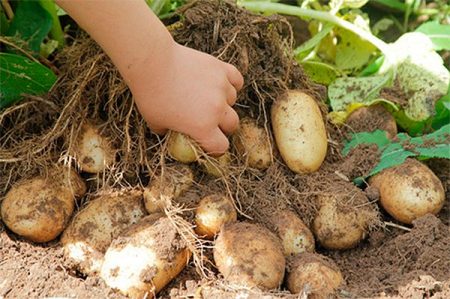
Sorcerer (Russia)
Bushes of medium height, with lush flowers and smooth leaves. The average weight of one tuber is 100 g, in the hole there are usually about 10. The yield is good, about 30 t / ha. Large and heavy tubers, thin peel, milky flesh. Good rates of keeping and transportation, resistance to deformation and mechanical damage. The variety is undemanding to soil, tolerates heat and drought, does not need special care. It is advisable to feed with nitrogen-containing fertilizers.
Adretta (Germany)
Landings are resistant to viral diseases, temperature extremes and difficult climates. Root crops are oval, elongated, with a beige flaky peel. The weight of one potato is up to 250 g, in each hole there are up to 10 pieces, the approximate yield of the variety is 350-400 c / ha. Great for long-term storage and transportation.
Tuleevsky (Russia)
A variety adapted to the climatic conditions of Russia. Deservedly considered one of the most delicious, has a thin peel. The total yield is about 300 c / ha. The variety is quite capricious: it requires abundant watering, cannot be stored for a long time and will quickly fade if stored improperly. Bushes are afraid of frost.
Rocco (Holland)
One of the most popular varieties in the world. It is important to remember that it has the ability not to bloom, but to develop normally. The mass of 1 tuber is 125 g, about 12 are formed on the bush, the final yield is 350-400 kg / ha in lean years and up to 600 kg / ha in ordinary years. Fruits are red, medium in size, often uneven. Shelf life - at least 5 months, tolerates transportation well. The variety is unpretentious, easily tolerates drought and rain, does not require special care.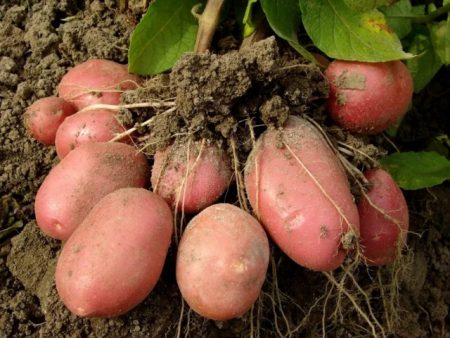
Aurora (Russia)
One bush brings 10-15 potatoes weighing 100-120 gr. The average yield is 30 t / ha. The tubers are round, with large eyes, the color is beige with a pink tint. It easily tolerates adverse weather conditions, especially drought. It requires thorough loosening of the soil and hilling. Immunity is average, there are no special requirements for care.
Later
It is more convenient for some gardeners to grow those varieties that ripen later than others. Let's explore the best of them.
Picasso (Netherlands)
The low yield (up to 240 c / ha) of this variety is balanced by its excellent taste. Due to the very thin peel, the fruits are not even peeled, but simply washed before cooking. When cooking, potatoes are ready in 15-20 minutes. Boiled potatoes are very crumbly and tender in taste. The variety is moody, it needs the right soil composition and amount of fertilizer, it is often sick and is attacked by pests. The tubers are elongated, beige, with pink spots.
Zhuravinka (Belarus)
The potatoes are rounded, reddish. The average weight of each is 120 g, in one nest, as a rule, 14-16 potatoes, sometimes up to 25. Approximate yield - 630 kg / ha. The variety is resistant to storage, undemanding to growing conditions, has medium immunity, is not afraid of mechanical damage. Requires moderate watering. Unstable to the Colorado potato beetle.
Reviews
All forums gardeners are full of discussions of this nightshade culture. Let's read the most interesting reviews.
Olya writes:
“How can you do without potatoes? This is the second product after bread. "And in a feast, and in the world, and in good people" - potatoes come in handy everywhere. This is a vegetable that goes for side dishes, salads, and soups, and ... you can’t count everything. There are hundreds of recipes where potatoes are used! Even diets are based on it. And it can also be used for personal care and treatment. It is a pity that now everyone is eating different newfangled dishes, forgetting about the traditional vegetable for Russia. After all, potatoes can be very gourmet if cooked correctly.
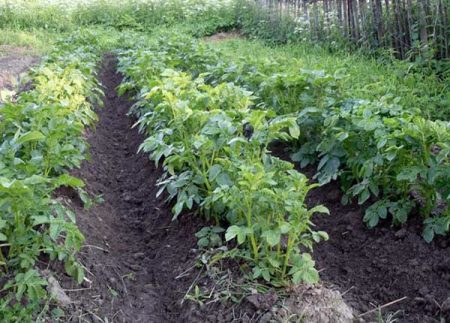
Anastasia writes:
“How many potato dishes do you know?” I sat here, I thought - personally, I know 63. And I looked through the culinary sites - there are hundreds or even thousands of them ... In general, the product is necessary. I have been growing some potatoes in the garden for several years. A small garden, only 10 square meters, where in the spring I plant a little Rocco. This is my favorite variety, it is very tasty and unpretentious. Of course, there is little harvest from such a garden. But what could be nicer than fresh early potatoes baked directly with the peel. "




 Description and description of varieties in Belarus with a photo
Description and description of varieties in Belarus with a photo Do I need to pick flowers from potatoes: why do they do it
Do I need to pick flowers from potatoes: why do they do it When to dig potatoes: timing and availability of new potatoes
When to dig potatoes: timing and availability of new potatoes How to grow a good potato crop: various methods and methods, planting and care
How to grow a good potato crop: various methods and methods, planting and care